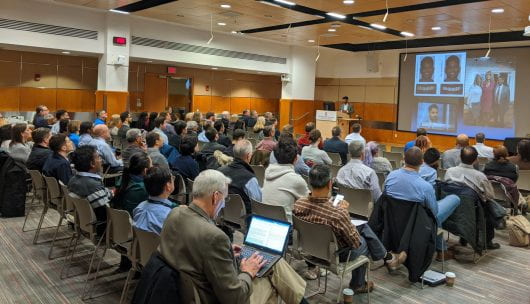
Inaugural speaker Dr. Das presents at Startup Inventor Showcase on his medical and entrepreneurial journey. Credit: Courtesy of Tanya Mathew
It is often said that if you want something done right, do it yourself, and inventors in the medical field at Ohio State have taken that phrase seriously.
Starting this semester, the Ohio State University Center for Clinical and Translational Science is highlighting biomedical and health inventors, their inventions and the resources that supported them and their businesses. Every month, CCTS will host its Startup Inventor Showcase that features a faculty member, clinician or other professional who has developed an original idea through their own startup company, Dr. Tanya Mathew, event organizer and administrator for CCTS’ Innovation, Commercialization and Entrepreneurship program, said.
The showcased inventions will aim to bring scientific discoveries and interventions to patients as quickly as possible, Mathew said.
“The average time that a breakthrough in science reaches the community or the patient is 17 years,” Mathew said. “Individuals living with rare diseases or conditions do not have that much time to wait for a new cure or treatment so there is an urgent need to speed up the translational process so life-saving treatments and cures can be delivered to patients faster.”
CCTS is funded by a multiyear Clinical and Translational Science Award from the National Institutes of Health to provide Ohio State and Nationwide Children’s Hospital biomedical researchers with financial, organizational, educational and infrastructural support, as well as opportunities for community members to participate in research.
Mathew said the acceleration of treatments to patients needs to be multidirectional, meaning researchers and clinicians should listen to what patients want and allow the feedback to influence research.
February’s featured inventor and speaker is Dr. Christopher Breuer, a professor of surgery at Ohio State and director of regenerative medicine and surgical research at Nationwide Children’s Hospital. Breuer said his research explores the use of new tissues to improve vascular grafts and be used in replacement heart valves for pediatric surgeries.
For more than 25 years, synthetic vascular grafts have been used in heart surgery for children, so when patients grow out of the graft, they have to go through surgery again, Breuer said. The tissues he developed are formed on a device called a “scaffold,” which works as a template for individual cells to multiply until they become tissues.
The scaffold is biodegradable, which means that once it has been surgically placed into the patient, they are left with a tissue structure that is entirely made of their own cells without any synthetic components, Breuer said.
For his February presentation, Breuer said he hopes to speak about learning to adapt to new opportunities, encouraging people to continue pursuing the idea that initially drew them toward the scientific community.
“It’s more than just science, and it’s more than just business. It’s really just about life and how we get to where we are at and try to live a life where you leave an impact and make things happen,” Breuer said.
Scott Osborne, vice president of economic and corporate engagement in the Office of Business and Finance at Ohio State, said in an email that Ohio State’s researchers play a role in solving some of the world’s most complex problems.
“The speakers in this series embody this spirit and we know they will inspire others around the university to explore similar pathways in getting their innovations into the marketplace where they can realize their full benefit,” Osborne said.
The inaugural speaker for the series and first inventor to be featured this semester was Dr. Subinoy Das, who began his medical career as a surgeon for head and neck injuries.
In January’s presentation, Das spoke on his experience as the chief medical officer of Tivic Health, which has developed ClearUp, a handheld device that emits small electric currents to the face to rapidly relieve headaches. The device was the recipient of Time Magazine’s Top Inventions of 2019.
As a medical professional and entrepreneur, Das said it is hard to meet people who are doing similar things, a problem he hopes is alleviated by the series.
“Our ultimate goal is to try to develop this entrepreneurial ecosystem where students and young faculty and young business people who have an interest in starting a new invention can all find a place to come together,” Das said.
The Startup Inventor Series will continue to take place each month for the rest of 2020 with a break during the summer, Mathew said.
This month’s series will take place from 7 to 9 a.m. Feb. 10 at the Wexner Medical Center at Ohio State Ross Conference Center. CCTS offers a livestream of the series at Arps Hall Conference Room 437 and Nationwide Children’s Hospital. Registration is required and can be done at https://redcap.bmi.osumc.edu/redcap/surveys/index.php?s=XFX3KPXFL9.
Note: A previous version of this headline contained the word “medicine.” It has since been updated to “health.”


